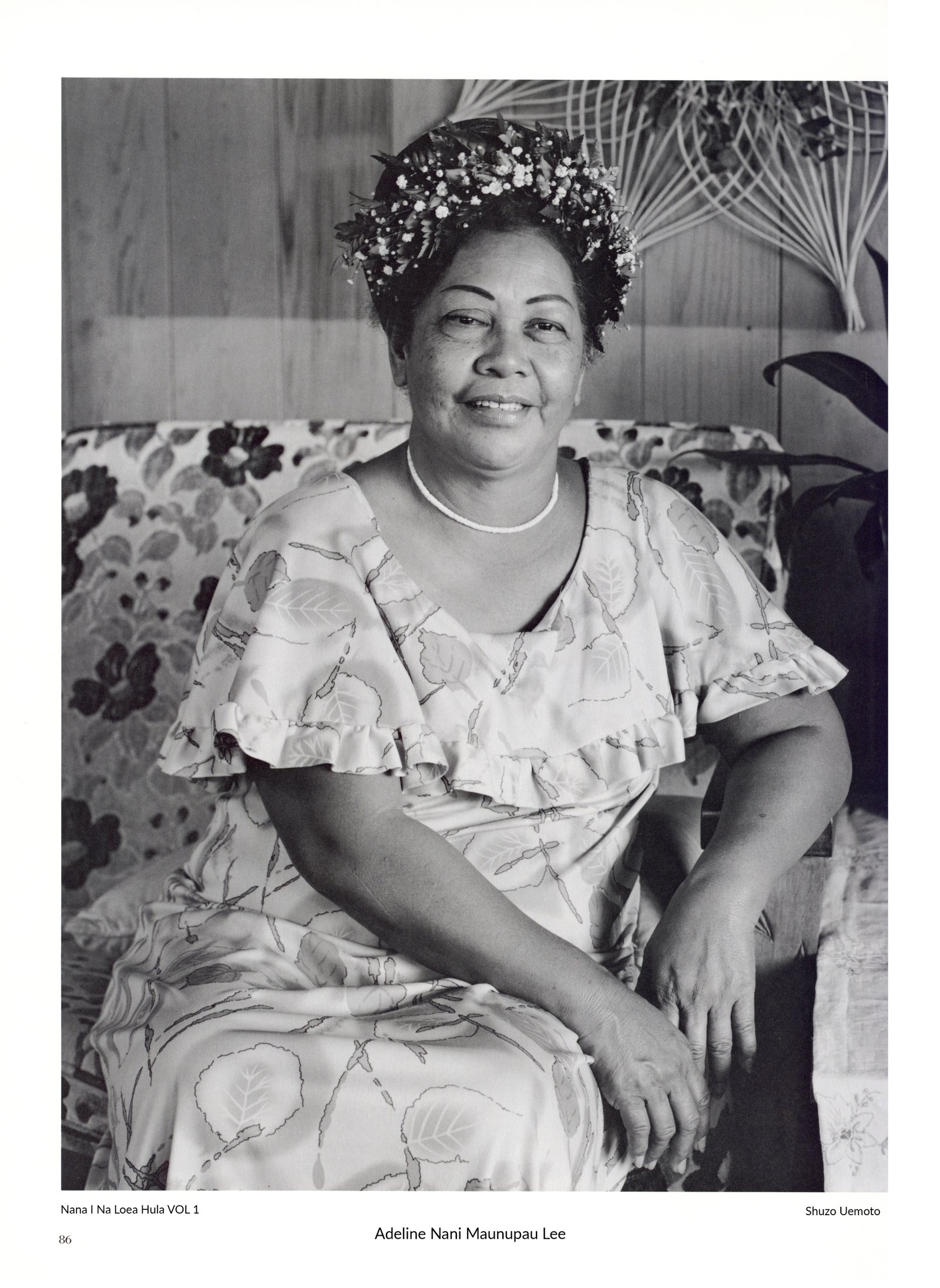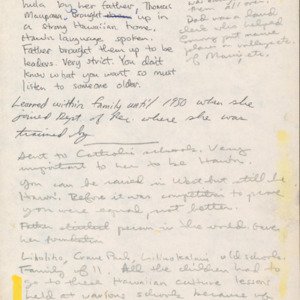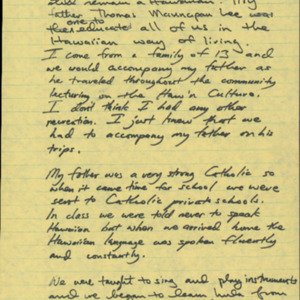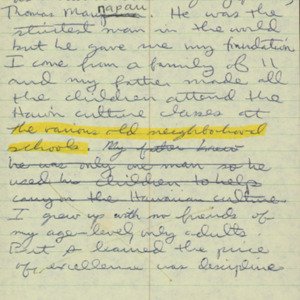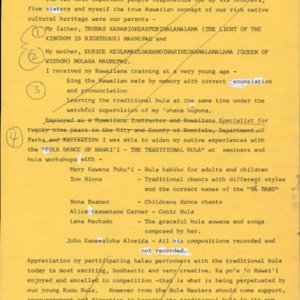Adeline Nani Maunupau Lee
Title
Adeline Nani Maunupau Lee
Subject
Nā Kumu Hula Adeline Nani Maunupau Lee - Nānā I Nā Loea Hula Volume 1 Page 87
Description
Adeline Lee has dedicated twenty-nine years as a Hawaiiana instructor for the Department of Parks and Recreation, City and County of Honolulu. She currently resides in Kapahulu, O‘ahu.
The best thing about my life today is that I am able to pass on my knowledge to an alaka‘i. The knowledge and tradition of the culture was given to me only to give out. How will people learn about and respect the culture if no one tells them about it? The responsibility of the kumu hula becomes then to choose someone who will be faithful to what is being passed down.
I come from a family of eleven and we were all taught to sing and play instruments from childhood. My father Thomas Kananiokeaupunimālamalama Maunupau and my mother Eunice Keolamauloakamō‘i- wahineokamālamalama Molaka Maunupau taught us that you can be raised in a Western world but still remain a Hawaiian. We were all sent to Catholic private schools where we were told never to speak Hawaiian but when we arrived home the language was spoken fluently and constantly.
My first kumu was my aunt Mrs. Baker. Family members would come and share with us any knowledge and training they had. I was trained at a very young age and we were taught to sing the Hawaiian mele by memory with the correct enunciation and pronunciation. In 1950 I joined the Department of Parks and Recreation and this was how I began to teach the hula. There was a required hula course that all the instructors had to attend and this was how I was able to learn under some of the great kumu hula of our culture. Nona Beamer taught us dances aimed specifically for children and more than that she showed us the joy of children and childhood. Tom Hiona taught us the names and styles of the different drum beats, and we were trained by Alice Keawekāne Garner in the comic side of the hula. Because we had to teach all ages of students, Aunty Mary Kawena Pūku‘i taught us a wide variety of traditional hula that was suitable for children and adults. In addition we were trained in hula ‘auwana and Hawaiian music by Aunty Lena Machado and John K. Almeida. Ten of us would go into these workshops and when we came out we would teach the same hula but it would be infused with our own personalities.
Basically what I see being done today in hula kahiko is the same thing that was done in my time. Today s hula is very bombastic. Creative, individual personalities have always brought out the different aspects of the hula but they have never changed the hula. The hula is too vast for that. There are one hundred different steps to the traditional hula but the most you can use in one hula is six. What I see today is a revival of what was done before. The young people love their culture so much they want to bring it out.
The teaching is so condensed today that in two hours a haumana must learn the chant, the step, the beat, and then the performance. In the end the students only want to learn the dance and not the entire preparation or performance of the hula.
I credit my father for giving me my background in the Hawaiian culture but when I was growing up I didn’t appreciate that kind of discipline in my life. I used to wish he would just let us run free. Today I am so grateful for the direction he gave me.
The best thing about my life today is that I am able to pass on my knowledge to an alaka‘i. The knowledge and tradition of the culture was given to me only to give out. How will people learn about and respect the culture if no one tells them about it? The responsibility of the kumu hula becomes then to choose someone who will be faithful to what is being passed down.
I come from a family of eleven and we were all taught to sing and play instruments from childhood. My father Thomas Kananiokeaupunimālamalama Maunupau and my mother Eunice Keolamauloakamō‘i- wahineokamālamalama Molaka Maunupau taught us that you can be raised in a Western world but still remain a Hawaiian. We were all sent to Catholic private schools where we were told never to speak Hawaiian but when we arrived home the language was spoken fluently and constantly.
My first kumu was my aunt Mrs. Baker. Family members would come and share with us any knowledge and training they had. I was trained at a very young age and we were taught to sing the Hawaiian mele by memory with the correct enunciation and pronunciation. In 1950 I joined the Department of Parks and Recreation and this was how I began to teach the hula. There was a required hula course that all the instructors had to attend and this was how I was able to learn under some of the great kumu hula of our culture. Nona Beamer taught us dances aimed specifically for children and more than that she showed us the joy of children and childhood. Tom Hiona taught us the names and styles of the different drum beats, and we were trained by Alice Keawekāne Garner in the comic side of the hula. Because we had to teach all ages of students, Aunty Mary Kawena Pūku‘i taught us a wide variety of traditional hula that was suitable for children and adults. In addition we were trained in hula ‘auwana and Hawaiian music by Aunty Lena Machado and John K. Almeida. Ten of us would go into these workshops and when we came out we would teach the same hula but it would be infused with our own personalities.
Basically what I see being done today in hula kahiko is the same thing that was done in my time. Today s hula is very bombastic. Creative, individual personalities have always brought out the different aspects of the hula but they have never changed the hula. The hula is too vast for that. There are one hundred different steps to the traditional hula but the most you can use in one hula is six. What I see today is a revival of what was done before. The young people love their culture so much they want to bring it out.
The teaching is so condensed today that in two hours a haumana must learn the chant, the step, the beat, and then the performance. In the end the students only want to learn the dance and not the entire preparation or performance of the hula.
I credit my father for giving me my background in the Hawaiian culture but when I was growing up I didn’t appreciate that kind of discipline in my life. I used to wish he would just let us run free. Today I am so grateful for the direction he gave me.
Citation
“Adeline Nani Maunupau Lee,” Nā Kumu Hula Archive, accessed September 16, 2025, https://nakumuhula.org/archive/items/show/63.
